#cultivating soybeans
Text
Reduction in soybean production costs attracts Bungoma youths
In Kenya, young people account for nearly 75 per cent of the population, with unemployment being a massive problem. However, agriculture has emerged as a solution to this problem by providing job opportunities to youth in various sectors.
Photo Credit: Harun Murithi
Eugene Wafula, the chairperson of Kibingei Machinery Ring in Kimilili sub-county, Bungoma County, is a young farmer who has found…
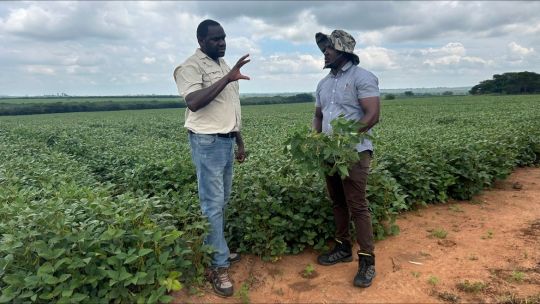
View On WordPress
#arming maize#beans#cultivating soybeans#Groundnuts#Irish potatoes#maize production#soya beans#soybean production
0 notes
Text
you'll don't even know how deep i am in bean wikipedia right now
5 notes
·
View notes
Text
soybean harvesting time in india
Learn about the ideal Soybean Harvesting Time in India and the best practices to ensure a successful harvest. Understand the signs of maturity, harvesting techniques, and post-harvest management for optimal results.
0 notes
Text
Jetez un œil à cette histoire que j'ai sauvegardée sur Pocket
Plant-based meats are a futurist mean, I think, for the near moment, cultivated-based meats are more flavorous, more accessible to the numerous multitude.
We need to count with the timeline even if climatic change set an urgent challenge...
After, the market will make the choice.
#nature#news#economy#history#humankind#fake meat#vegetal#soybeans#carbon cost#water cost#profitability#taste#popularity#real meat cultivated#timeline
0 notes
Text

---



For the Maya, the honey bee is more than an insect. For millennia, the tiny, stingless species Melipona beecheii -- much smaller than Apis mellifera, the European honey bee -- has been revered in the Maya homeland in what is now Central America. Honey made by the animal the Maya call Xunan kab has long been used in a sacred drink, and as medicine to treat a whole host of ailments, from fevers to animal bites. The god of bees appears in relief on the walls of the imposing seacliff fortress of Tulum, the sprawling inland complex of Cobá, and at other ancient sites.
Today, in small, open-sided, thatched-roof structures deep in the tropical forests of Mexico’s Yucatán Peninsula, traditional beekeepers still tend to Xunan kab colonies. The bees emerge from narrow openings in their hollow log homes each morning to forage for pollen and nectar among the lush forest flowers and, increasingly, the cultivated crops beyond the forests’ shrinking borders. And that is where the sacred bee of the Maya gets into trouble.
---
In 2012, the Mexican government granted permission to Monsanto to plant genetically modified soybeans in Campeche and other states on the peninsula without first consulting local communities. The soybeans are engineered to withstand high doses of the controversial weedkiller Roundup; multiple studies have shown exposure to its main ingredient, glyphosate, negatively impacts bees, including by impairing behavior and changing the composition of the animals’ gut microbiome. Though soy is self-pollinating and doesn’t rely on insects, bees do visit the plants while foraging, collecting nectar and pollen as they go. Soon, Maya beekeepers found their bees disoriented and dying in high numbers. And Leydy Pech found her voice.
A traditional Maya beekeeper from the small Campeche city of Hopelchén, Pech had long advocated for sustainable agriculture and the integration of Indigenous knowledge into modern practice. But the new threat to her Xunan kab stirred her to action as never before. She led an assault on the Monsanto program on multiple fronts: legal, academic, and public outrage, including staging protests at ancient Maya sites. The crux of the legal argument by Pech and her allies was that the government had violated its own law by failing to consult with Indigenous communities before granting the permit to Monsanto. In 2015, Mexico’s Supreme Court unanimously agreed. Two years later, the government revoked the permit to plant the crops.
---
As Pech saw it, the fight was not simply about protecting the sacred bee. The campaign was to protect entire ecosystems, the communities that rely on them, and a way of life increasingly threatened by the rise of industrial agriculture, climate change, and deforestation.
“Bees depend on the plants in the forest to produce honey,” she told the public radio program Living on Earth in 2021. “So, less forest means less honey [...]. Struggles like these are long and generational. [...] ”
---
Headline, images, captions, and all text by: Gemma Tarlach. “The Keeper of Sacred Bees Who Took on a Giant.” Atlas Obscura. 23 March 2022. [The first image in this post was not included with Atlas Obscura’s article, but was added by me. Photo by The Goldman Environmental Prize, from “The Ladies of Honey: Protecting Bees and Preserving Tradition,” published online in May 2021. With caption added by me.]
4K notes
·
View notes
Text
I just don't see any enviroment as pristine or free of human influence. I don't see humans as being apart of nature. And I don't see human activity on nature as inmoral or undesirable. Which does not mean I support paving over everything or building farms everywhere. I just think humans build landscapes, it's what they do.
Whenever being hunter-gatherers in cultivated forests, creating rice terraces, building skyscrapers, managing silviculture systems, deforesting to plant soybean monoculture, creating aquaculture in the deep sea, building small fishing towns, or preserving rainforests for tourism, humans are just part of nature. It is our culture that defines what kind of landscapes, what kind of ecosystems, grow around us.
We can either embrace this and build landscapes and ecosystems that will allow us to preserve our planet and recognize the importance of nature to our well-being, or keep the stupid "humans are a plague" way of thinking and keep the sharp dichotomy human/nature, which will only bring us to half-solutions at best.
#cosas mias#ecology#and yes regarding the recent discussion we will carry this to space (because we will go to space) and build landscapes in space#and they will be affected and build on what our culture considers important and what kind of resource use we employ#space is also a part of nature it is and will be the biggest part of nature someday
273 notes
·
View notes
Text

Today In History
Dr. George Washington Carver was an agricultural scientist and inventor who developed hundreds of products using peanuts, sweet potatoes and soybeans. He is believed to have been born the month of January in 1864.
Dr. Carver discovered over 300 products from peanuts, soybeans and sweet potatoes, which aided nutrition for farm families.
Dr. Carver wanted to improve the lot of “the man farthest down,” the poor, one-horse farmer at the mercy of the market and chained to land exhausted by cotton.
Unlike other agricultural researchers of his time, Dr. Carver saw the need to devise practical farming methods for this kind of farmer. He wanted to coax them away from cotton to such soil-enhancing, protein-rich crops as soybeans and peanuts and to teach them self-sufficiency and conservation.
He achieved this through an innovative series of free, simply-written brochures that included information on crops, cultivation techniques, and recipes for nutritious meals. He also urged the farmers to submit samples of their soil and water for analysis and taught them livestock care and food preservation techniques.
Dr. Carver took a holistic approach to knowledge, which embraced faith and inquiry in a unified quest for truth. Carver also believed that commitment to a larger reality is necessary if science and technology are to serve human needs rather than the egos of the powerful.
His belief in service was a direct outgrowth and expression of his wedding of inquiry and commitment.
One of his favorite sayings was:
“It is not the style of clothes one wears, neither the kind of automobile one drives, nor the amount of money one has in the bank, that counts. These mean nothing. It is simply service that measures success.”
CARTER™️ Magazine
#george washington carver#carter magazine#carter#historyandhiphop365#wherehistoryandhiphopmeet#history#cartermagazine#today in history#staywoke#blackhistory#blackhistorymonth
54 notes
·
View notes
Text
Iowa is grappling with a stark and troubling reality: the state has recently been identified as having the fastest-growing cancer rates in the nation. This alarming increase in cancer rates has prompted a closer examination of environmental factors contributing to this troubling trend. A 2024 report by the Iowa Department of Public Health reveals that cancer rates in rural areas of the state, where pesticide use is more intensive, are significantly higher compared to urban regions. The study highlights that communities with heavy agricultural activity have seen a rise in cases of leukemia, lymphoma and breast cancer.
Iowa’s cancerous frontier dominated by glyphosate, atrazine, nitrates, chlorpyrifos
Iowa has seen a dramatic rise in cancer diagnoses, with 486 new cases per 100,000 people in 2024, surpassing the national average of 444 cases per 100,000. The estimated number of new cancer cases this year stands at 21,000, with approximately 6,100 deaths expected. This surge in cancer rates is particularly concerning given that Iowa's cancer incidence now outpaces other states facing their own unique health challenges, such as industrial pollution, smoking and high obesity rates.
The state, known for its expansive agricultural landscape, relies heavily on pesticides to protect crops and maximize yields. The state’s agriculture sector uses a variety of chemical treatments, including herbicides, insecticides and fungicides. The most commonly used pesticides in Iowa include glyphosate, atrazine and chlorpyrifos.
Glyphosate, a broad-spectrum herbicide, is used extensively in the cultivation of corn and soybeans. Glyphosate disrupts the shikimate pathway of gut microbes and has been linked to an increased risk of non-Hodgkin lymphoma, a type of cancer that affects the lymphatic system.
Atrazine, another herbicide, is frequently applied to control weeds in cornfields. Atrazine has been associated with endocrine disruption, which may increase the risk of certain cancers. Studies have found atrazine is responsible for alterations in the HPG axis, damaging reproductive function. It also has estrogenic effects, leading to aromatase activation, including inhibition of PDE4 and altered hormone secretion — precursors to breast cancer.
9 notes
·
View notes
Text
French group sold agribusiness insurance for soybean plantations on Indigenous lands in southern Brazil
An investigation by Brasil de Fato found that, despite defying legislation, the company got a federal subsidy

The Brazilian insurance company Essor, part of the giant French reinsurance group Scor, sold agribusiness insurance for the illegal cultivation of soy within the Monte Caseros Indigenous Land, in the towns of Ibiraiaras and Muliterno, both in the state of Rio Grande do Sul, southern Brazil.
The sale was subsidized by the Rural Insurance Premium Subsidy Program (PSR, in Portuguese), an initiative through which the federal government subsidizes part of insurance purchases with public money. The PSR funds come from the Harvest Plan.
The insurance policies were hired between 2020 and 2021 by Pedemar Cirino Rodrigues and Sandro Vazzoler, two men claiming to be farmers in Rio Grande do Sul. The area insured by Essor within the Monte Caseros Indigenous Lands totals 110.7 hectares.
At the beginning of 2022, Essor unilaterally broke off the contract with the two men, claiming it was Indigenous land, a state asset. At that time, intense droughts in southern Brazil doubled the compensation paid to farmers, threatening the financial health of insurance companies.
Continue reading.
#brazil#brazilian politics#politics#environmental justice#indigenous rights#farming#image description in alt#mod nise da silveira
8 notes
·
View notes
Text
In what is being called a significant victory for Mexico, Monsanto has withdrawn its legal challenge against the 2020 presidential decree aimed at banning glyphosate and genetically modified (GM) corn for human consumption.
The National Council of Humanities, Sciences and Technologies (Conahcyt) heralded the decision as “a triumph for life, health and food sovereignty.”
Monsanto’s subsidiaries, Semillas y Agroproductos Monsanto and Monsanto Comercial, ratified their withdrawal on June 25.
Monsanto produces the herbicide Roundup, one of several glyphosate-based products that are used in the cultivation of genetically modified organisms (GMO) such as Roundup Ready corn, cotton and soybeans. A common genetic modification makes crops resistant to glyphosate, allowing farmers to apply large amounts of the weed-killer to GMO crops.
The legal battle was initiated in response to President Andrés Manuel López Obrador’s 2020 decree to ban the widely used but controversial herbicide, which the World Health Organization (WHO) has classified as a “probable carcinogen,” though its safety remains a subject of debate.
The battle included over 30 amparo (judicial protective order) suits aiming to declare the decree unconstitutional. In July 2022, for example, Bayer, which acquired Monsanto six years ago, obtained a court order against the application of the decree. -However, the majority of the cases concluded with rulings unfavorable to the corporations involved.
continue reading
8 notes
·
View notes
Text
This species only arrived in North America nine years ago, but it has already spread to over a dozen states in the US (particularly in the Northeast) and is spreading beyond that. These flies--especially in their nymph form--can be incredibly destructive to plant life here, including various fruit trees, soybeans, and other crops, as well as several species of native tree. Their primary predator, a parasitic wasp, does not exist here, and none of our native wasps have yet been seen to use this species as a host.
People in all US States, as well as Canada and Mexico, should keep their eyes out for the nymphs and adults, as well as the egg clusters, and are encouraged to smash them with impunity. We've seen how much damage other invasive species can do to both natural and cultivated spaces, and while it's unlikely we can completely eliminate them, we can at least curb them.
ID info and other relevant stuff about spotted lanternflies can be found here.
#spotted lanternfly#insects#invasive species#North America#United States#bugs#invertebrates#gardening#farming#agriculture#ecology#nature#wildlife
86 notes
·
View notes
Text
What does your kinky garden look like?
No seriously. What does it look like? You should always be striving to cultivate trust between you and your partner in a bdsm dynamic and I say that to ask: have you checked on your kinky garden lately? What does your kinky garden look like?
Plant your kinky seeds with intention and structure your garden how you want it to best fit your needs.
Where does the spanking tree go? Does it go front and center where it's easily accessible or do you need it in the back to help shade and give your domestic discipline clematis something to climb on so it can thrive? Do you even need a spanking tree or do you just feel pressure to have one?
Develop your garden and make sure it's getting plenty of sunlight and water and attention. The edging around the orgasm control bush may need more careful tending to in order to keep it healthy because your partner gets so sensitive to touch.
Meanwhile the obedience peonies seem to do fine all on their own because your partner loves being obedient so they don't need as much reinforcement, but still need nurturing.
Maybe you found it more enjoyable and less intense for you to have cat-tail mouth gags at the water's edge rather than latex hood lilypads in your garden's pond.
Maybe your kinky garden is a zen garden because you're asexual. You keep around plenty of bondage bonsai's and masochism hedges, but you don't need any blowjob bluebells or intercourse irises in your kinky garden like most of your neighbors do.
Also did you make sure to use the praise mulch on your degradation daisies like your partner asked? They won't grow without it they said!
Maybe you'll have an unforeseen allergic reaction to the hotwife heather you planted and you can't keep that plant around, but that's okay, that's why we keep a hard limit compost pile near the soft limit locked shed. What's important is you tried and found it didn't work for you.
Maintain your garden and when the ears of butt plug corn aren't looking healthy, ask questions, be supportive, and do your research and plant waxplay soybeans instead to rotate with the corn. So you have variety
And remember that sometimes you may need to leave patches of your garden alone to let the soil get healthy and fill with nutrients again so that your kink garden can thrive and plants can be added.
How your kinky garden is cultivated matters.
To cultivate means to "to make an effort to establish, develop, and maintain a relationship." You can have whatever rules you decide on in your power dynamic and kinky fun, but just make sure you cultivate your relationship like you would a garden.
Trust is vital and connection is everything. Cultivate your kinky relationship like a garden and it will flourish, but flourishing never occurs without effort.
What does your kinky garden look like?
5 notes
·
View notes
Photo

Brazil’s natural resources
The fertile lands of Brazil, located in different climatic zones, favor the cultivation of many products such as soybeans, sugar cane, coffee…. These lands also allow the development of extensive livestock farming. Underground resources are numerous.
by @LegendesCarto
147 notes
·
View notes
Text
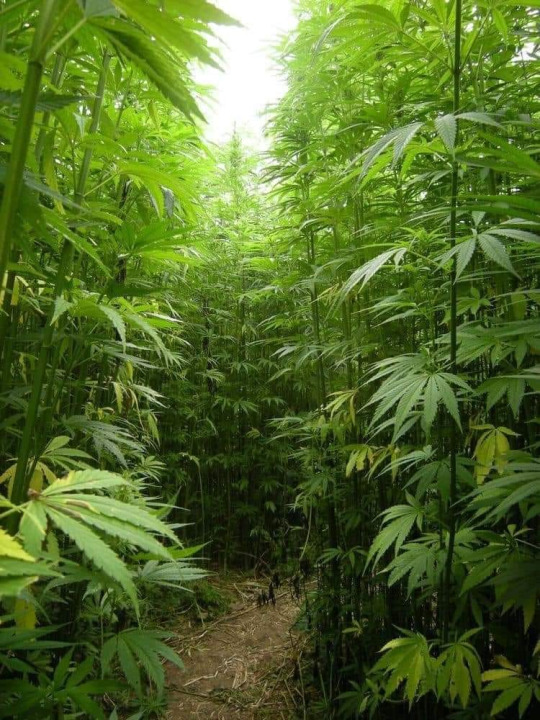
Interesting facts about cannabis.
1. One hectare of cannabis releases as much oxygen as 25 hectares of forest.
2. From one hectare of cannabis you can get as much paper as from 4 hectares of wood.
3. Whereas hemp can be made into paper 8 times (recycle), wood can be made to paper 3 times. Hemp paper is the best and strongest.
4. Hemp grows in 4 months, and the tree grows in 20-50 years.
5. Hemp flower is a real radiation trap. Cannabis plantations purify the air.
6. Hemp can be cultivated anywhere in the world, it needs very little water.
Besides, since it can protect itself from pesticides, it does not need pesticides.
7. Hemp textiles surpasses even linen products in its properties.
8. Hemp is an ideal plant for making ropes, ropes, cords, bags, shoes, headwear.
9. Cannabis.
It is banned in many countries. But technical cannabis is drug-free.
10. The protein value of cannabis seeds is very high, and the two fatty acids in it are no longer found anywhere else in nature.
11. It is much cheaper to produce hemp than soybeans.
12. Animals fed with cannabis do not need hormonal support.
13. All plastic products can be made from hemp, and hemp plastic is eco-friendly and fully biodegradable.
14. If the car body is made of cannabis-based composite material, it will be 10 times stronger.
15. Hemp can also be used to heat insulation of buildings, it is durable, cheap and flexible.
16. Soap and cosmetics made of cannabis do not contaminate water, so it is completely environmentally friendly.
source: sisters of the valley
21 notes
·
View notes
Text
Growing foxtial millet, QMYS Section 3, Part 1
Continuing the Qimin yaoshu齊民要術 (“Essential Techniques for the Common People) by Jia Sixie (fl. c. 540). Advice for growing foxtail millet. Due to the length of this section, the translation will be divided into several posts. This post covers the introductionary dictionary definitions and Jia Sixie's own advice. Subsequent posts will cover the extensive quotations from earlier works.
[Translator's preface]
After opening the book with two general sections on tilling the fields and selecting seed grain, sections 3-54 cover the cultivation of specific plants (field crops, vegetables, fruit- and timber-trees, dye plants). The first, and lengthiest, of these is dedicated to the foxtail millet (Setaria italica). Known under many names, in Jia Sixie's home region it was often simply referred to as gu穀, “grain”. I suppose you could draw parallel to calling maize “corn” in English. Foxtail millet was first domesticated in North China during the Neolithic and remained the main staple crop there during the Early Medieval North China, . As such, by the time QMYS was written, Jia Sixie could draw on several millennia of experience with foxtail millet farming.


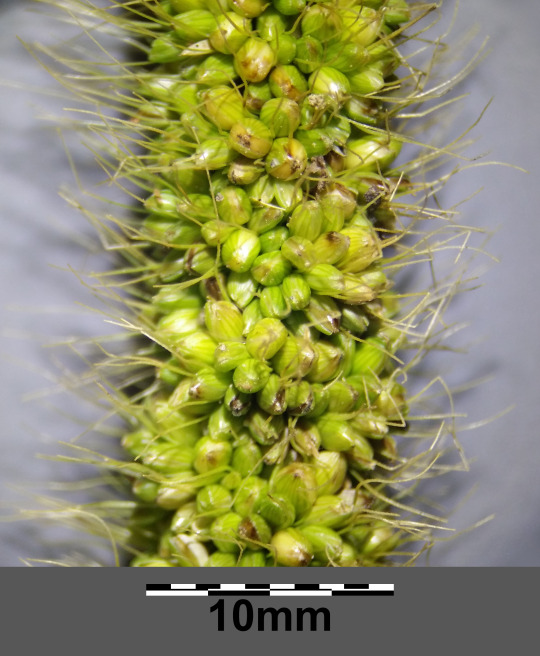
[Other plants mentioned]
Certain other plants are mentioned more incidental in this section.
Plants more or less suited to precede foxtail millet in a crop rotation system:
Mung beans or green gram (Vigna radiata), lüdou緑豆 (lit. "green beans"), used as green manure in crop rotation with millet.

Adzuki beans (Vigna angularis), xiaodou小豆 (lit. "small beans") served a similar function.
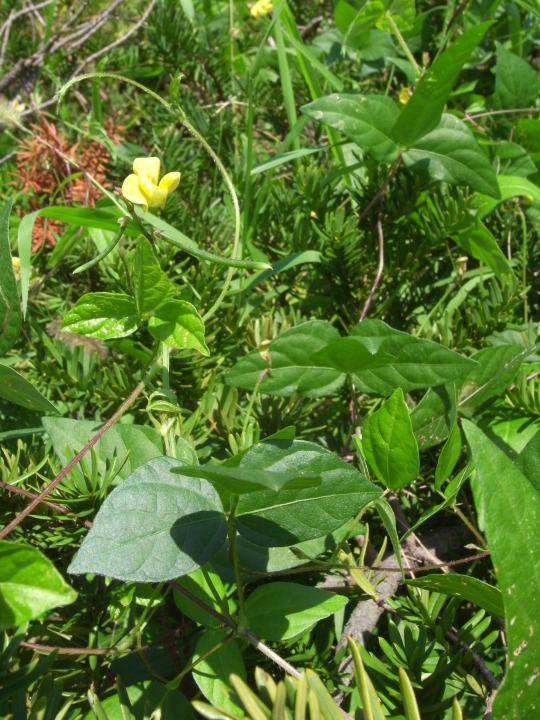
Hemp (Cannabis sativa), ma麻, grown both for textiles and oil

Broomcorn millet (Panicum miliaceum), shu黍, popular for brewing millet beer

Sesame (Sesamum indicum), huma胡麻 (lit. “foreign hemp”), considered the best oilseed crop

Turnip (Brassica rapa var. rapa),wujin蕪菁, leaves and roots are edible, and the seeds can be pressed for oil.

Soybean (Glycine max) dadou大豆 (lit. “large beans”), used as fodder or famine crop, but also fermented into sauces, etc.
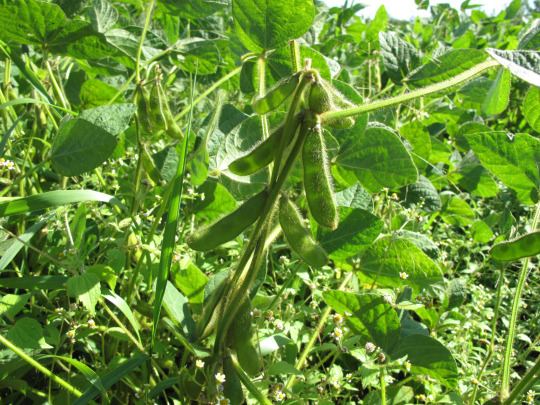
Gua底 is a general term for gourds and melons
Trees whose leaves and flowers can be used to predict the best time for sowing foxtail millet:
Beiyang菩楊 appear to refer to some kind of willow (Salix) or poplar (Populus)

Peach (Prunus persica), tao 桃

Jujube (Ziziphus jujube), zao棗
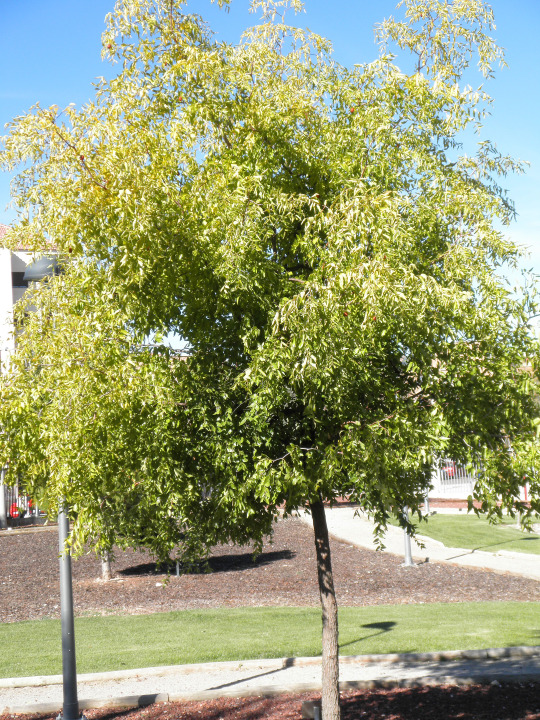
Mulberry (Morus alba), sang桑

[Tools]
The illustrations below are taken from Wang Zhen's王禎 (1271-1333) Nongshu農書, who of course wrote several centuries after Jia Shixie. While many tools were essentially timeless and in continuous use up to the modern age, developments did happen, and also terminology could change.
The preferred tool for sowing was the seed drill, lou耬
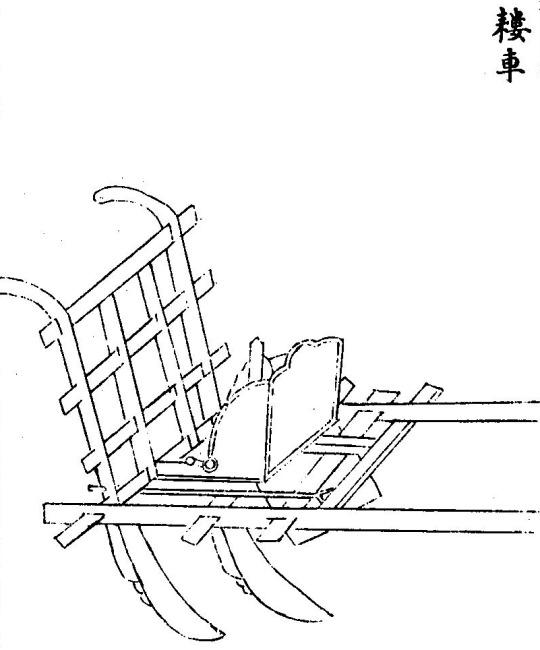
(Wang Zhen's louche耬車).
The “beater”, ta撻, (for a lack of a better translation) was pulled over the furrows after sowing to compact them. Wang Zhen describes this tool as a bunch of branches weighed down by stones.
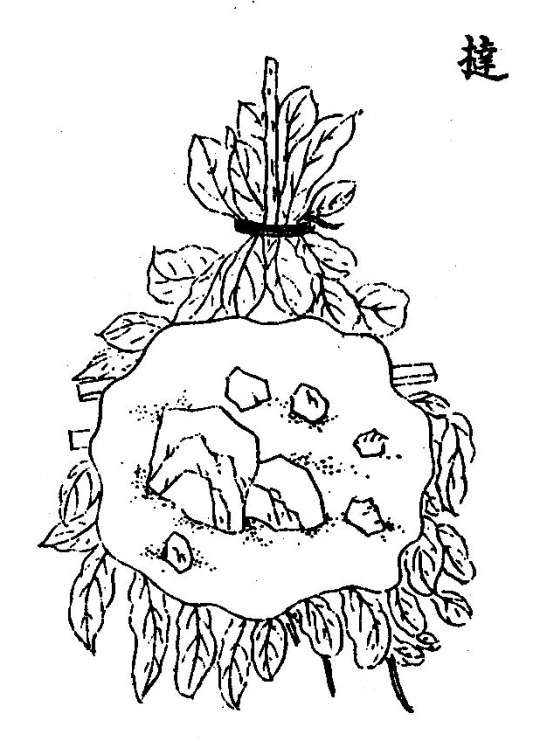
The arrowhead hoe, zuchuo鏃鋤 was a small, pointed hoe. According to Wang Zhen, arrowhead hoeing was one of four methods for hoeing with the youchu耰鋤.
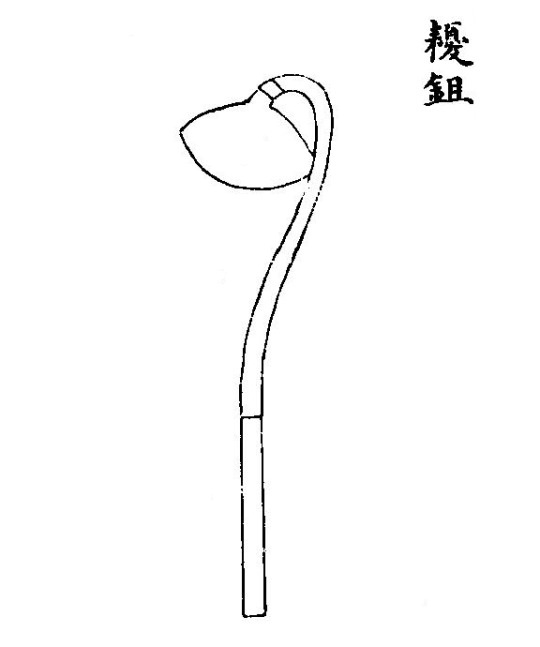
QMYS is the oldest text to refer to the iron-tine rake, tiechi loucou鐵齒𨫒楱

QMYS quite often refer to the spear-harrow, feng鋒. Wang Zhen notes that by his time it was no longer in use, his description of it as a cross between a plough and a spade may therefore not be very accurate.

The sickle, yi刈, was the main tool for reaping field crops.
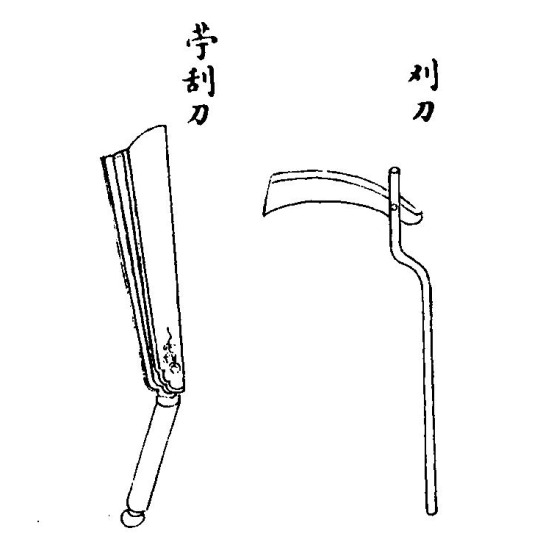
(Wang Zhen's yidao刈刀)
[Books quoted by QMYS in Section 3, in order of appearance]
The Erya爾雅 (“Approaching the Correct”) is the oldest surviving Chinese glossary. Modern scholarship dates the book to the late Warring States and/or early Western Han periods. It is quoted numerous times in QMYS. This is the second QMYS section to quote from the Erya. The last previous was Section 1 (“Tilling the Fields”).
The Shuowen 說文 (“Explaining Graphs”) by Xu Shen許慎 (c. 58 – c. 147) analyses the composition and reasoning behind the different characters. It is quoted numerous times in QMYS. This is the second QMYS section to quote from the Shuowen. The last previous was Section 1 (“Tilling the Fields”).
The Guangzhi廣志 (“Wide Treatise”) by Guo Yigong郭義恭 (Western Jin) is now lost, but it is quoted numerous times in QMYS and other books. This is the first QMYS section to quote from the Guangzhi.
Guo Pu郭璞(276 – 324) was a Daoist wizard, poet and writer. His surviving writings include the oldest extant commentary on the Erya and a commentary on the Shanhaijing. This is the first QMYS section to quote Guo Pu, from his Erya commentary.
Sun Yan孫炎 lived during Wei and was disciple of Zheng Xuan. He wrote (a now lost) commentary on the Erya where he pioneered the use of the fanqie system to indicate pronunciation. This is the first QMYS section to quote Sun Yan.
Liu Zhang 劉章(200 – 176) was a grandson of the Han founder. According to the Shiji he recited the Gengtian ge 耕田歌 (“Song of Ploughing the Fields”)at a banquet during the regency of Empress Dowager Lü, to show his opposition to the Lü clan's power, and he later became one of the main actors in their downfall.
The Guanzi管子 (“Master Guan”) is a collection of treatises on statecraft traditionally attributed to Guan Zhong管子 (d. 645 BC9), an influential minister in Qi during the Spring and Autumn era. Section 3 contains the third quote from the Guanzi in QMYS, the first two are in the preface (which I have impudently skipped).
[The original text is a mix of large and small characters. I have collected the small text sections together as indented notes within {} brackets.]
[Translation starts here]
Section 3, Growing Foxtail millet
Growing foxtail millet [gu穀]:
{“Grain” gu穀 and “foxtail millet” ji稷 are names for setaria millet [su粟]. Grain is the collective name for the Five Grains, and does not mean setaria millet. However, today people solely consider foxtail millet to be “grain”, and [I] look to the customary name for it, and that is all.}
[For the remainder, gu穀 will be translated as “foxtail millet” in the sections written by Jia Sixie, ji稷 will generally be rendered also as “foxtail millet”, and su粟 as “setaria millet” (or just “foxtail” and “setaria”).]
{The Approaching the Correctsays: “Zi粢 is foxtail millet [ji稷].”}
{The Explaining Graphs says: “Setaria millet [su粟] is the fruit of excellent grain [gu穀].”}
{Guo Yigong's Broad Treatise says: “The names of the kinds are Red Setaria and White Stem, Black-Patterned Sparrow Setaria, Duke Zhang's Mottled, Enclosed Yellow-Iron-green, Dark-green Foxtail, Snow-White Millet – likewise named White Stem, also White-Indigo Short, Bamboo Head-Stem Dark-green, White Wheat-Catching, Stone-Pulling Purest, Earth-black Dog-Paw.”}
{Guo Pu's Annotations to the Approaching the Correct says: “Today in Jiangdong they call foxtail millet zi粢.”}
{Sun Yan says: “Foxtail [ji稷] is setaria [su粟]”}
{Note that the present age's names for setaria, many uses a person's family and courtesy names as the label name. There are likewise those where look and form established the names, and likewise those where what happened to be appropriate became the designation, [I] rely on them then to set them out, and that is all:}
{Vermillion Foxtail, Highland Yellow, Liu Zhuxie, Daomin Yellow, Whittled-Grain Yellow, Sparrow's Regret Yellow, Continued Life Yellow, Hundred Days Grain, Upright Wife Yellow, Unworthy-of-Rice Grain, Slave Child Yellow, Jiazhi Foxtail, Schorced Gold Yellow, Quail's Slipper Iron-green which is also named Wheat's Floor-Fighter: These fourteen types ripen early and endure drought, early ripening avoids insects. The Whittled-Grain Yellow and Unworthy-of-Rice Grain types have a pleasing taste.}
{Now-Fell-off-the-Chariot, Short Horse-Carer, Hundred Flock Sheep, Hanging Snake Red-Tail, Bear-Tiger Yellow, Sparrow's and People's Benefit, Horse Reins, Liu Pig Red, Li Yu Yellow, Amba Grain, Donghai Yellow, Rocky lesuo䮑歲, Dark-green-Stalked Dark-green, Dark Excellent Yellow, South-of-the-Paths Crop, Nook-and-Dike Yellow, Song Ji's Idiocy, Point Out Yellow, Rabbit Foot Dark-green, Kind Sun Yellow, Shifting Wind Red, Single Sunlight Yellow, Mountain Saline, Dundang Yellow: These twenty-four types all have spikes with bristles, endure wind, and avoid harassment from sparrows. The Single Sunlight Yellow type is easy to hull.}
{Precious Pearls Yellow, Popular Gain White, Zhang Lin Yellow, White Salt Foxtail, Thousand Hooks Yellow, Zhang Yi Yellow, Gleaming Tiger Yellow, Chief Slave Red, Reed-Stalk Yellow, Xun Pig Red, Wei Shuang Yellow, White-Stalked Dark-green, Bamboo-Rooted Yellow, Attuned Mother Large-grained millet, Rock-Pile Yellow, Liu Sand-White, Seng Long-lasting Yellow, Red Large-grained Foxtail, Auspicous Swift Yellow, Otter-Tail Dark-green, Continued Potency Yellow, Concave-Straw Yellow, Sun Long-lasting Yellow, Pig-Shit Dark-green, Smoking Yellow, Happy Slave-girl Dark-green, Level Long-life Yellow, Deer Stubble White, Salt for Breaking Baskets, Yellow dianshan, Hilly Place Yellow, Red Ba Large-grained millet, Deer Hoof Yellow, Famished Dog Iron-green, Can-be-Pitied Yellow, Hulled Foxtail, Deer Stubble Dark-green, Aluoluo: These thirty-eight types are the single stems great foxtails? [the received QMYS text is defective at this point]. The White Salt Foxtail and Attuned Mother Large-grained millet types have a pleasing taste. The three Concave-Straw Yellow, Hilly Place Yellow and Pig-Shit Dark-green types are bad tasting. The Yellow dianshan and Happy Slave-girl Dark-green types are easy to hull.}
{Bamboo-Leaf Dark-green and Rocky Yichu, Bamboo-Leaf Dark-green is also named Hu Foxtail, Water Black Foxtail, Swift Mud Dark-green, Charging Heaven Cudgels, Pheasant Chick Dark-green, Owl-Foot Foxtail, Goose-Head Dark-green, Hold-Piles Yellow, Dark-green Hawk-cuckoo: These ten types ripen late and endure floods. If there is a calamity of insects, they are consumed.}
In general there is foxtail which is fully ripened early or late, which sprouts and straw are tall or low, which harvest results are large or small, which natural quality is strong or weak, which hulled grain taste good or bad, which grain results in gains or losses{A}. The conditions of the land can be good or poor{B}, and mountains and marshes differ in what is suitable{C}. Obey Heaven's seasons, and evaluate the land's advantages, then [you] will employ little strength yet achieve success many times. Rely on feelings and go against the Way, [you] will toil and yet get nothing.{D}
{A: Those that ripen early have short sprouts and the harvest is large. Those that ripen late have long sprouts and the harvest is small. Those which strong sprouts are short, and belong to the yellow foxtail. Those which weak sprouts are long, and are dark-green, white, or black. Those with small harvests are good but make losses. Those with large harvests are bad but make gains.}
{B: Good fields are suitable for late types, poor fields are suitable for early types. Good land is not solely suitable for late types, early types are also not harmful. Poor land is suitable for early types, late types will certainly not give successful result.}
{C: For mountain fields, types with strong sprouts, to avoid wind and frost. For marsh fields, types with weak sprouts, to aspire to splendid results.}
{D: Enter a spring to chop wood and climb a mountain to look for fish, and the hand will surely be empty. To face the wind when sprinkling water, or to go against the slope when moving a pellet, these conditions are difficult.}
In general for foxtail fields, mung beans or adzuki beans as the previous crop is the best; hemp, broomcorn millet, and sesame are next; turnip and soy beans are last.
{It is common to see gourds as the previous crop, they are no less than mung beans. Originally they were not discussed, for the moment then keep it in mind.} [This note may be a later addition.]
For 1 mu of good land, use 5 sheng of seeds, and for poor land 3 sheng.{A} Foxtail fields certainly must be changed annually.{B} Those sown in the 2nd Month or the 3rd Month are the early-planted grain. Those sown in the 4th or 5th Month are the late-planted grain. From 2nd Month, First Ten-day, until the hemp and beiyang willow sprout seeds is the best time. 3rd Month, First Ten-day, until the Pure and Clear [qingming] Period and the peach tree first flower is the middle time. 4th Month, First Ten-day until the jujube leaves sprout and the mulberry flowers fall is the worst time. For those which the yearly Way ought to be late, the beginning of the Fifth Month or Sixth Month are also possible.
{A: This is for early-planted foxtail, for late fields increase the number of plants.}
{B: If twice sowing the seeds, the weeds will be many, and the harvest poor.}
In general spring sowing wish to be deep, and ought to be dragged with a heavy “beater”. Summer spring wish to be shallow, and just sprout from itself.
{Spring air is cold, and sprouting is slow. If not dragged with a “beater”, they will set root in hollows, and even if they sprout, they will immediately die. Summer air is hot, and they sprout quickly. [If] dragged with the “beater” and there happens to be rain, [the ground] will surely be hard and dry. Those in the spring that are very moist sometimes also are not necessary to beat. To be certain they want beating, [you] ought necessarily to wait for [the ground] to turn white. Wet beating will cause the ground to be hard and tough is the reason.}
In general when sowing foxtail, after rain is good. If there is a little rain, [you] ought accept the wetness and sow. If there is great rain, wait for the weeds to sprout.{A} During spring, if there is drought, on the land of the autumn tilling [you] might open the mounds and wait for rain.{B} During summer, if there are open mounds, not only will it sweep away and wash out that which does not grow, [but] in addition it and the grassy weeds will set forth together.
{A: [If] there is a little rain and [you] do not accept the wetness, there is nothing to give birth to the stalks sprouting. [If] there is great rain and [you] do not wait for [the ground] to turn white, wet rolling then will cause the sprouts to be frail. If weeds are abundant, to first hoe one time everywhere and afterwards accept sowing then will be good.}
{B: On the spring-tilled, it does not hit the mark.}
In general the fields that want early or late are mixed together.{A} In years that are intercalary, after the solar periods draw close, [you] ought to have late fields. However for the most part [you] want early, early fields yield more than late.{B}
{A: Prepare for what is proper in the Way of the year.}
{B: Early fields are clean and easy to manage. The late ones overgrow with weeds and are difficult to manage. Their harvest, regardless of large or small, follows from is proper for the year, and is not connected to early or late. However, early foxtail have thin husks, the hulled grains are solid and many. Late foxtail have thick husks, the hulled grain are small and empty.}
When the sprouts have grown similar to horse ears, then arrowhead hoe.{A} At places with gaps and holes, hoe and patch them.{B} In general for the Five Grains, only the small hoe is good.{C} For good fields, usually for each chi [foot], keep one hole.{D} For poor land, seek out mounds and tread on them.{E}
{A: The proverb says: “Want to get foxtail, at horse ears the arrowhead.” }
{B: The work done might not be overstated. The profit gained this way is a hundred times.}
{C: The small hoe not only saves strength, the grain is also twice as good. With a large hoe, the grass and their roots will be profuse and thick, a lot of work will be done yet the harvest will grow smaller.}
{D: Liu Zhang's Song of Tilling the Fields says: “Plough deeply and sow thickly, the standing sprouts want to be spread out. For those not of their kind, hoe and get rid of them. The proverb which states: “[When you can] turn around the chariot and reverse the horse, [or] throw away the clothes [and they] do not fall down, both give ten shi when harvested” tells that harvest for [fields that are] very sparse or very thick are all equal and even.}
{E: Not tilling is the reason.}
When the sprouts spring forth from the mounds, hoe deeply. When hoeing, do not get bored with the frequency. Once done, start again. [You] must not stop though there is no grass.{A} Spring hoeing is to lift up the earth, and summer to remove grass. For that reason, spring hoeing is not done when facing wetness. By the 6th Month and after, even if wet, in this case is not disliked.{B}
{A: Hoe not just to remove the grass, then the land will ripen and the fruit will be many, the chaff will be weak, and the hulled grain will grow. When hoeing is done ten times everywhere, [you] will then obtain “Eight [parts of ten?] Hulled grain”.}
{B: During spring, as the sprouts are just then slight and their shade are not yet covering the ground, if wet hoeing, the ground will become hard. During summer, the sprouts cast a solid shade and the ground does not see the sun. For that reason, even if wet, in this case there is no harm. Master Guan says: “To make a state, cause the farmers to till when cold and weed [yun芸] when hot.” To weed is to remove grass.}
When the sprouts have sprung from the mounds, each time [you] have gone through rain, in the time [the ground] turns white, immediately use the iron-tine rake across and athwart to rake and harrow them.
{Method for raking: Make a person sit down on top, and frequently use their hands to tear off and get rid of grass, if grass block up the tines it will harm the sprouts. Like this [you] will make the ground ripe and soft, easy to hoe and save strength. When hitting the spear-harrow, stop.}
When the sprouts are one chi high, spear-harrow them.{A} Tillage is not about not embedding the root sprouts deeply, it kills the grass and increase the results, however it will make the ground hard and tough, lacking in moisture and difficult to till. Hoe five times everywhere or more, and it will not be bothersome to till.{B}
{A: Three times everywhere is always good.}
{B: When for sure [you] want to till, after you have reaped the foxtail, if you promptly spear-harrow below the roots to burst them up, it will be soft and moist, and easy to till.}
In general when sowing, [you] want the ox to move slow and leisurely. The sower makes hurried steps to tread the mound base with his feet.
{If the ox is slow, the seeds will be evenly placed. If trod with the feet, the sprouts will thrive. When the footsteps connect with each other, it is possible to not bother with beating.}
When ripe, reap quickly. When dry, store quickly.
{If reaped early, the sickle-use will be excessive. If reaped late, the spikes will break. If there is wind, the harvest will diminish. If stored wet, the stalks will rot. If stored late, there is loss and waste. If continuous rain, they will grow ears.}
In general for the Five Grains, for the most part those sown in the first ten-day will give a full harvest, those in the middle ten-day a middle harvest, and those in the last ten-day a lesser harvest.
7 notes
·
View notes
